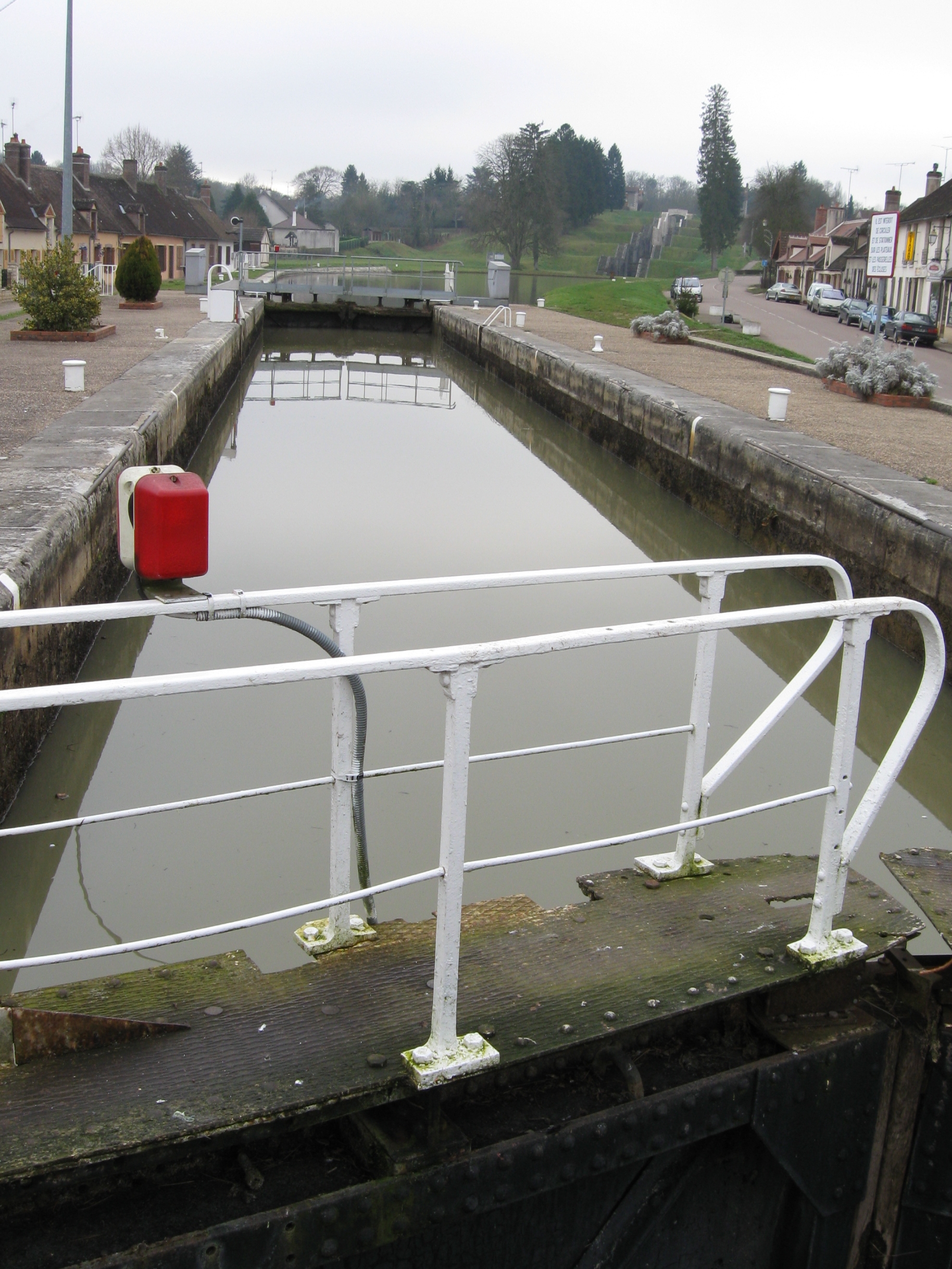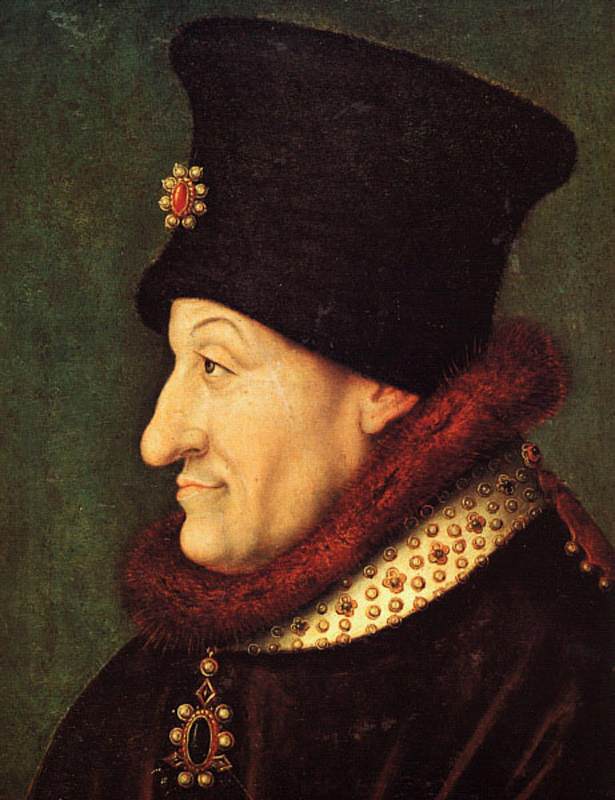|
Briare Canal
The Briare Canal (french: Canal de Briare, ) is one of the oldest canals in France. Its construction started in 1604. It was the first summit level canal in Europe that was built using pound locks, connecting the Rhone-Saône and Seine valleys. It is long and is part of the Bourbonnais route from Saint-Mammès on the Seine to Chalon-sur-Saône on the Saône. From Briare to Buges, the canal rises through the first 12 locks some and then falls through the remaining 24 locks. Construction The canal was initiated by Maximilien de Béthune, duc de Sully, with support from Henry IV in order to develop the grain trade, and to reduce food shortages. Its construction started in 1604 and was completed in 1642. Between 6,000 and 12,000 labourers worked on this canal which connects the basins of the rivers Loire and Seine. Hugues Cosnier obtained the contract to build the second canal crossing a watershed in Europe, involving many more locks than on the first. It was thus necessary to ... [...More Info...] [...Related Items...] OR: [Wikipedia] [Google] [Baidu] |
Montbouy - 06
Montbouy () is a commune in the Loiret department in north-central France. Geography The Aveyron river flows into the Loing in the commune. History Neolithic artefacts have been found on each side of the Loing river, downstream from Montbouy near Craon.Les théâtres ruraux des Carnutes et des Sénons : leur implantation et leurs rapports avec la Civitas Mrs F. Dumasy. In ''Revue archéologique du Centre de la France'', 1974, Vol. 13, n°13-3-4, pp. 195-218. Many remains suggest that Montbouy was one of the |
Sancerre
Sancerre () is a medieval hilltop town (ville) and commune in the Cher department, France overlooking the river Loire. It is noted for its wine. History Located in the area of Gaul settled by the powerful Celtic (Gaule Celtique) tribe, the Bituriges, or the "Kings of the World", and after their defeat at Bourges (Avaricum), part of Roman Aquitania. Some evidence points to the existence of an early hillside Roman temple dedicated to Julius Caesar; located on the Roman road (Gordaine) from Bourges to the river town of Gordona (Castle-Gordon), now Saint Thibault and Saint Satur. Name possibly derived from "Sacred to Caesar" and later Christianized to "Saint-Cere". During the Carolingian period there was a small village on the hillside, clustered around the Saint Romble Church. An Augustinian abbey was founded in Saint Satur in 1034. A natural fortress 312 meters in height, Sancerre is a former feudal possession of the Counts of Champagne (1152) in the province of Berry. They buil ... [...More Info...] [...Related Items...] OR: [Wikipedia] [Google] [Baidu] |
Beaujolais
Beaujolais ( , ) is a French ''Appellation d'Origine Contrôlée'' (AOC) wine generally made of the Gamay grape, which has a thin skin and is low in tannins. Like most AOC wines they are not labeled varietally. Whites from the region, which make up only 1% of its production, are made mostly with Chardonnay grapes though Aligoté is also permitted until 2024 (on condition the vines were planted before 2004). Beaujolais tends to be a very light-bodied red wine, with relatively high amounts of acidity. In some vintages, Beaujolais produces more wine than the Burgundy wine regions of Chablis, Côte d'Or, Côte Chalonnaise and Mâconnais put together.J. Robinson (ed.). ''The Oxford Companion to Wine'' (Third Ed.), pp 72–74. Oxford University Press, 2006. . The wine takes its name from the historical Province of Beaujolais, a wine-producing region. It is located north of Lyon, and covers parts of the north of the department of Rhône, the Rhône-Alpes region and southern areas ... [...More Info...] [...Related Items...] OR: [Wikipedia] [Google] [Baidu] |
Mâcon
Mâcon (), historically anglicised as Mascon, is a city in east-central France. It is the prefecture of the department of Saône-et-Loire in Bourgogne-Franche-Comté. Mâcon is home to near 34,000 residents, who are referred to in French as Mâconnais. The city gave its name to the nearby vineyards and wine 'appellation'. Geography The city lies on the western bank of the river Saône, between Bresse in the east and the Beaujolais hills in the south. Mâcon is the southernmost city in the department of Saône-et-Loire and the region of Bourgogne-Franche-Comté. It is north of Lyon and from Paris. The climate is temperate with a slight continental tendency. Climate Mâcon features an oceanic climate (Köppen: ''Cfb''), with warm summers, slightly too cool to be called humid subtropical (''Cfa''). Winters are relatively cold to French standards, but milder and more rainy than north of Mâcon. Most precipitation is in spring and autumn. History Ancient and Medieval eras The ... [...More Info...] [...Related Items...] OR: [Wikipedia] [Google] [Baidu] |
Auvergne (province)
The history of the Auvergne dates back to the early Middle Ages, when it was a historic province in south central France. It was originally the feudal domain of the Counts of Auvergne. History Auvergne was a province of France deriving its name from the '' Arverni'', a Gallic tribe who once occupied the area, well known for its fierce resistance, led by Vercingetorix, to conquest by Julius Caesar and the late Roman Republic. Christianized by Saint Austremoine, Auvergne was quite prosperous during the Roman period. After a short time under the Visigoths, it was conquered by the Franks in 507. During the earlier medieval period, Auvergne was a county within the duchy of Aquitaine and from time to time part of the "Angevin Empire". In 1225, Louis VIII of France granted Poitou and Auvergne to his third son Alfonso.Elizabeth M. Hallam, ''Capetian France: 987–1328'', London: Longman, 1980, p. 248. On Alfonso's death in 1271, Auvergne, along with the County of Toulouse, Poitou and ... [...More Info...] [...Related Items...] OR: [Wikipedia] [Google] [Baidu] |
Étang De La Gazonne
'','' ( en, "Grassy Pond"), is a lake that provides water for the workings of the Canal de Briare. Hugues Cosnier Hugues Cosnier () was a French engineer who conceived of the Briare Canal who was born in Tours, 1573, and died in 1629. in Paris He proposed to Henri IV the idea of building a canal from the Loire River to the River Seine. It would go from Bri ..., designer of the canal, planned a waterway from the River Trezée to the Gazonne. The Gazonne acted as a reservoir. References {{DEFAULTSORT:Gazonne Lakes of Centre-Val de Loire ... [...More Info...] [...Related Items...] OR: [Wikipedia] [Google] [Baidu] |
Louis XIII Of France
Louis XIII (; sometimes called the Just; 27 September 1601 – 14 May 1643) was King of France from 1610 until his death in 1643 and King of Navarre (as Louis II) from 1610 to 1620, when the crown of Navarre was merged with the French crown. Shortly before his ninth birthday, Louis became king of France and Navarre after his father Henry IV was assassinated. His mother, Marie de' Medici, acted as regent during his minority. Mismanagement of the kingdom and ceaseless political intrigues by Marie and her Italian favourites led the young king to take power in 1617 by exiling his mother and executing her followers, including Concino Concini, the most influential Italian at the French court. Louis XIII, taciturn and suspicious, relied heavily on his chief ministers, first Charles d'Albert, duc de Luynes and then Cardinal Richelieu, to govern the Kingdom of France. The King and the Cardinal are remembered for establishing the '' Académie française'', and ending the revolt o ... [...More Info...] [...Related Items...] OR: [Wikipedia] [Google] [Baidu] |
Jacques Guyon
Ancient and noble French family names, Jacques, Jacq, or James are believed to originate from the Middle Ages in the historic northwest Brittany region in France, and have since spread around the world over the centuries. To date, there are over one hundred identified noble families related to the surname by the Nobility & Gentry of Great Britain & Ireland. Origins The origin of this surname ultimately originates from the Latin, Jacobus which belongs to an unknown progenitor. Jacobus comes from the Hebrew name, Yaakov, which translates as "one who follows" or "to follow after". Ancient history A French knight returning from the Crusades in the Holy Lands probably adopted the surname from "Saint Jacques" (or "James the Greater"). James the Greater was one of Jesus' Twelve Apostles, and is believed to be the first martyred apostle. Being endowed with this surname was an honor at the time and it is likely that the Church allowed it because of acts during the Crusades. Indeed, ... [...More Info...] [...Related Items...] OR: [Wikipedia] [Google] [Baidu] |
Guillaume Boutheroue
Guillaume Boutheroue was a French engineer who completed the Briare Canal, originated by Hugues Cosnier. In 1623, he was the Poor Rate and Tax Collector at Beaugency. In 1638, along with his brother-in-law Jacques Guyon, he obtained letters patent from Louis XIII allowing them to complete the Canal de Briare. The canal was completed in 1642. See also * Briare Canal * Hugues Cosnier Hugues Cosnier () was a French engineer who conceived of the Briare Canal who was born in Tours, 1573, and died in 1629. in Paris He proposed to Henri IV the idea of building a canal from the Loire River to the River Seine. It would go from Bri ... References French canal engineers Year of death unknown Year of birth unknown {{france-engineer-stub ... [...More Info...] [...Related Items...] OR: [Wikipedia] [Google] [Baidu] |
Rogny-les-Sept-Écluses
Rogny-les-Sept-Écluses () is a commune in the Yonne department in Bourgogne-Franche-Comté in north-central France. The name of the commune comes from its impressive seven locks on Briare Canal. Geography The commune is located some west of Auxerre and is crossed by the Loing and the Briare Canal. It is situated at 20 km north of Gien and 140 km south of Paris. The commune is in the natural area of Puisaye, History Rogny-les-sept-écluses was simply known as Rogny before 1978, when the name was changed to mirror its famous monument. Human settlement in the area dates back to Roman times. Medals and coins bearing the image of the Emperor Constantine (306-337) and the Gaulish tyran Tetricus (268) were found along an ancient Roman road. In the Middle Ages, the lower part of the village was on wetlands, so most of the villagers lived around the church on the higher part of the village. Written traces from the 11th century indicate that the village now known as Rogny ... [...More Info...] [...Related Items...] OR: [Wikipedia] [Google] [Baidu] |
Hugues Cosnier
Hugues Cosnier () was a French engineer who conceived of the Briare Canal who was born in Tours, 1573, and died in 1629. in Paris He proposed to Henri IV the idea of building a canal from the Loire River to the River Seine. It would go from Briare to Montargis and then continue to the Seine via the Loing River. Cosnier began the canal in March 1604. He abandoned the project in 1610 with the death of Henri IV. In 1620, he was invited to continue his work on the canal. His death prevented him continuing the effort. Guillaume Boutheroue completed the canal between 1638 and 1642. Also in 1603, he received a grant to establish silkworm breeding, sericulture, in Poitou Poitou (, , ; ; Poitevin: ''Poetou'') was a province of west-central France whose capital city was Poitiers. Both Poitou and Poitiers are named after the Pictones Gallic tribe. Geography The main historical cities are Poitiers (historical c .... The endeavor failed. In 1618, his idea of encircling Paris with c ... [...More Info...] [...Related Items...] OR: [Wikipedia] [Google] [Baidu] |




